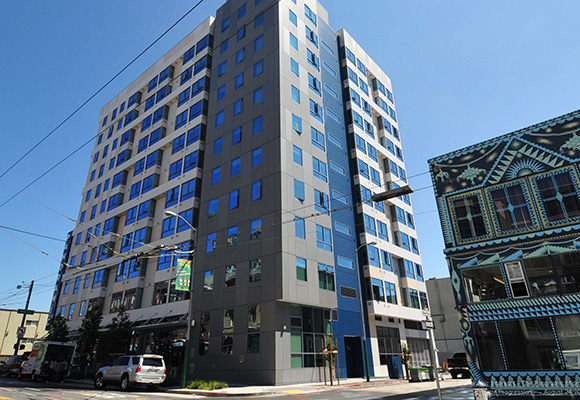
(Photo Credit: Panoramic Interests)
If you watch cable television, you undoubtedly have seen a myriad of shows about tiny houses and small spaces. The tiny house movement is geared toward those who want to live a simple life without all the “stuff” accumulated in our consumer-driven society. But, can tiny houses and small spaces also be the solution to affordable living?
One San Francisco developer thinks it can by building “micro-unit” apartments.
Panoramic Interests builds high-density, at-market rate apartment buildings using small or micro units in San Francisco and Berkeley. One of its buildings, The Panoramic in San Francisco's Mid-Market neighborhood, has 160 units, including 120 studios that are less than 300 square feet and can accommodate two people. Although it was built for the general market, the California College of the Arts has leased all of the building’s units for student housing.
Another of Panoramic developments currently being built in Berkeley includes four-bedroom units at 690 square feet (standard four-bedroom apartments in the area range from 1,300-1,700 square feet).
According to the company’s founder, Patrick Kennedy, creating more housing units–even small ones will ease the affordability crisis. “Giving people more choices takes some of the pressure off. If we can build, say, 10,000 units of micro-pads in San Francisco both for the homeless and the newly arrived workforce that’s coming into San Francisco in droves, there would not be as much pressure bidding up housing in the Mission and the Richmond and all the typical resident/family neighborhoods.”
Kennedy outlined three points that he thinks can increase the housing stock and, as a result, make homes more affordable. First, he said that developers should be allowed to build according to form-based zoning as opposed to density per square foot of land. Form-based zoning focuses on the character of the environment to achieve a certain form and scale.
“We’re fine with zoning ordinances,” said Kennedy. “But we think that if you really want to maximize housing opportunities, you should let the developers decide the number of units they can build in a four- or five-story building.”
Second, cities should be flexible with parking requirements, especially in high-density cities such as San Francisco, where many residents don't own cars and rely of public transit and ride-sharing companies. “Parking requirements are very expensive to comply with and very often bear no relation to the actual need for parking in a particular location,” said Kennedy.
Third, Kennedy advocates for a different way of building that may be more cost effective. “We do need to build rental housing in a way that standardizes the design and takes advantage of the industrial capacity of manufacturing versus onsite construction.”
He used as an example the design of Panoramic Interests’ Micro Pads, modular units that are built offsite, then shipped to and placed at the development. The company sees Micro Pads as a way to provide supportive housing the homeless population.
Kennedy also believes micro-unit apartments could also a good solution for people moving to San Francisco to work in the tech industry, or possibly for older individuals who are down-sizing, but still want to live in the City.
“If the City of San Francisco would give me permits, I could build 10,000 studio apartments in two years,” he said. “That’s the equivalent of one to two years' housing production for the whole city. Part of the problem is that we have just not produced anything for single people coming to the City.”
Increasing the housing stock using innovative ways may be one way to make housing more affordable. But oftentimes, innovation may collide with current laws and regulations, both local and statewide. One of the goals of the Summit's housing action plan in the 2016 Roadmap to Shared Prosperity is to explore ways to streamline housing development, making it easier to create more units and, in turn, lower costs to renters and homeowners.

